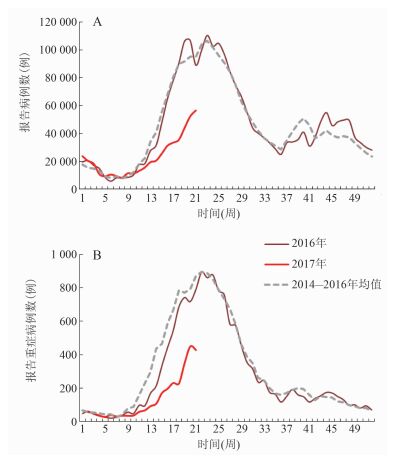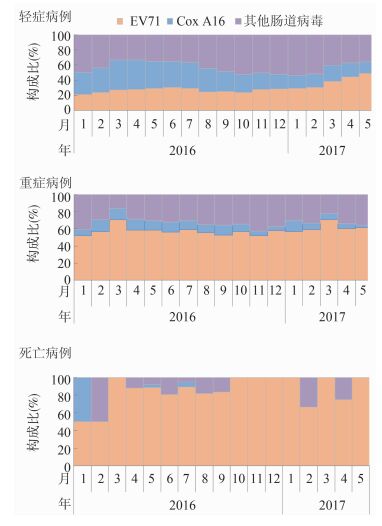扩展功能
文章信息
- 常昭瑞, 刘凤凤, 吕斌, 王周超, 曾令佳, 李中杰, 廖巧红
- CHANG Zhao-rui, LIU Feng-feng, LYU Bin, WANG Zhou-chao, ZENG Ling-jia, LI Zhong-jie, LIAO Qiao-hong
- 2017年1-5月全国手足口病疫情形势分析
- Analysis on surveillance data of hand, foot and mouth disease in China, January-May 2017
- 疾病监测, 2017, 32(6): 447-452
- Disease Surveillance, 2017, 32(6): 447-452
- 10.3784/j.issn.1003-9961.2017.06.003
-
文章历史
- 收稿日期:2017-06-10
2. 湖北省孝感市疾病预防控制中心传防所, 湖北 孝感 432100;
3. 辽宁省疾病预防控制中心感染与传染性疾病防制所, 辽宁 沈阳 110005
2. Institute of Infectious Disease Control and Prevention, Xiaogan Prefecture Center for Disease Control and Prevention, Xiaogan 432100, Hubei, China;
3. Institute of Infectious Disease Control and Prevention, Liaoning Provincial Center for Disease Control and Prevention, Shenyang 110005, Liaoning, China
手足口病(hand,foot and mouth disease,HFMD)是由多种肠道病毒引起的儿童常见传染病,肠道病毒71型(EV71) 和柯萨奇病毒A组16型(Cox A16) 是其主要病原。近几年,国内外由柯萨奇病毒A组6型(Cox A6) 和10型(Cox A10) 等肠道病毒引起的手足口病已引起科学界关注[1-5]。手足口病于1957年新西兰首次报道,1958年分离出Cox A16。1969年,美国加利福尼亚州从1例脑炎患儿的粪便标本中首次分离出EV71[6],此后,全世界很多国家和地区报道了EV71的流行。20世纪90年代后,手足口病的暴发或流行在亚太地区表现得非常活跃[6-8]。我国于1981年在上海市首次报道手足口病,1998年深圳市首次分离出EV71。2007年以来,我国手足口病流行日趋严重,并有重症和死亡病例出现[9-10]。为加强对手足口病的防控,2008年5月2日手足口病纳入丙类法定报告传染病管理。目前正值手足口病快速上升期,本文旨在流行高峰前期,对2017年15月手足口病流行强度、疾病严重程度、肠道病毒循环血清型的变化趋势及重点关注地区进行分析和风险提示,提出防控建议。
1 资料与方法1.1 数据来源手足口病病例人口学信息(性别、出生日期、现住址)、发病时间、诊断时间、病例类型(临床诊断、实验室诊断)、病例严重程度(重症、死亡)及病原学结果(EV71、Cox A16及其他肠道病毒)等基本信息来源于“中国疾病预防控制信息系统”中“传染病报告信息管理系统”。
1.2 病例定义临床诊断病例是发热伴手部、足部、口腔或臀部有丘疹或疱疹,部分病例可无发热。确诊病例是临床诊断病例经实验室检测(特异性RNA检测阳性、病毒分离阳性或急性期与恢复期血清病毒中和抗体升高4倍以上)证实为肠道病毒感染[11]。重症病例是出现神经系统受累表现(无菌性脑膜炎、脑炎、脑脊髓炎、急性弛缓性麻痹或自主神经系统失调)和/或心肺并发症(肺水肿、肺出血或心肺功能衰竭);无上述症状者为轻症病例[12]。
1.3 统计学分析采用Excel 2010软件进行手足口病流行特征描述性分析。分析指标主要包括:手足口病流行强度(发病数、重症数、死亡数)、严重程度(重症比例、病死率和重症病死率)、不同临床严重程度病例年龄别发病率及病原构成变化。年龄别发病率的计算为年龄别病例数与相应年龄段人口数相除,乘以100万计算而得,其中年龄别发病数通过个案数据中发病日期与出生日期相减计算年龄后分组汇总获得。病原构成汇总数据分析去除湖北省,仅对全国30个省份数据进行分析。采用ArcGIS 10.0软件制作手足口病发病、重症和死亡病例分布及病原构成分布地图。
2 结果2.1 流行特征2017年1月1日至5月31日,全国累计报告手足口病病例498 947例,其中重症病例3 161例,死亡47例。报告发病率36.4/10万,重症比例0.6%,病死率为0.009%,重症死亡比例为1.5%。与2016年同期相比,报告病例数、重症数和死亡数分别下降40.7%、39.7%和30.9%。重症比例、病死率和重症死亡比例分别上升1.7%、16.5%和14.6%,见表 1。
| 项目 | 2017年1—5月 | 与2016年同期相比(%) |
| 发病数 | 498 947 | -40.7 |
| 重症数 | 3 161 | -39.7 |
| 死亡数 | 47 | -30.9 |
| 重症/病例数(%) | 0.6 | 1.7 |
| 死亡/病例数(%) | 0.009 | 16.5 |
| 死亡/重症数(%) | 1.5 | 14.6 |
2017年手足口病自第11周起报告病例数逐步上升,疫情上升速度和流行强度均低于2016年同期水平,见图 1A。重症病例时间分布与总体疫情一致,见图 1B。

|
| 图 1 2014年1月至2017年5月全国手足口病报告病例(A)及重症病例(B)时间分布 Figure 1 Time distribution of HFMD cases(A) and severe HFMD cases(B)in China, January 2014-May 2017 |
| |
手足口病年龄分布特征与往年相同,不同年龄组发病率有差异。高发年龄主要集中在6~59月龄,但不同临床严重程度病例高发年龄略有差别,轻症病例、重症病例以12~23月龄发病率最高,死亡率以6~11月龄最高,其次为12~23月龄,见表 2。
| 年龄组 (月龄) | 轻症发病率 (/100万) | 重症率 (/100万) | 死亡率 (/100万) |
| <6 | 691.8 | 8.0 | 0.3 |
| 6~ | 4 106.3 | 30.3 | 1.1 |
| 12~ | 7 940.4 | 71.9 | 1.0 |
| 24~ | 6 331.9 | 44.9 | 0.5 |
| 36~ | 6 077.1 | 29.8 | 0.3 |
| 48~ | 4 025.1 | 15.7 | 0.3 |
| ≥60 | 45.3 | 0.1 | 0.0 |
报告病例集中在南部省份,报告病例数居前5位的省(自治区)依次是广东、广西、湖南、江苏和四川(图 2A);报告发病率居前5位的省(自治区)依次是广西、海南、湖南、广东和重庆(图 2B)。与2016年同期相比,全国仅9个省份报告病例数增加,病例数增加前5位的省(自治区、直辖市)为四川、重庆、山东、山西、内蒙古,占9省增加病例总数的93.3%。24个省份报告重症病例,主要集中在西南部和中部省份,居前5位的省(自治区)广西、河南、贵州、湖南和云南报告重症数占全国重症总数的71.6%(图 2 C)。与2016年同期相比,全国有5个省报告重症病例数增加,山东省和陕西省增加较多,两省增加重症数占增加总数的89.2%。

|
| 图 2 2017年15月全国手足口病发病数(A)、发病率(B)、重症和死亡病例(C)地区分布 Figure 2 Geographical distribution of HFMD cases(A)、morbidity(B) and severe and fatal HFMD cases(C) in China January-May 2017 |
| |
47例死亡病例分布在18个省份(图 2C)。与2016年同期相比,7个省份死亡数增加,其中福建省增加最多(3例),其次为重庆市和山东省(增加2例)。
2.2 病原学特征2017年15月全国30个省(去除湖北省)20 586例实验室诊断病例中,EV71、Cox A16和其他肠道病毒构成比分别为41.4%、17.0%和41.6%。与2016年同期相比,Cox A16构成比下降17.2个百分点,EV71和其他肠道病毒构成比分别上升11.2个和6.0个百分点。轻症病例中EV71、Cox A16和其他肠道病毒构成比分别占40.2%,17.8%和42.0%;重症病例中EV71、Cox A16和其他肠道病毒构成比分别为61.9%、5.2%和32.9%;28例实验室确诊死亡病例中EV71感染26例(92.9%),2例为其他肠道病毒感染。各省病原构成分析,全国16个省份仍以其他肠道病毒为优势血清型;以EV71为优势血清型的省份为14个;以Cox A16为优势血清型的省份为1个,见图 3。与2016年同期相比,EV71构成增加的省份有23个,其中西藏、内蒙古、宁夏、山东、山西、陕西和福建等省(自治区)增加30个百分点以上。

|
| 图 3 2017年15月全国手足口病实验室确诊病例血清型构成分布 Figure 3 Geographical distribution of proportion of enterovirus serotypes in laboratory-confirmed HFMD cases in China, January-May 2017 |
| |
2017年15月,总体看仍以其他肠道病毒为优势循环血清型,轻症病例中EV71构成逐渐升高,重症病例和死亡病例中EV71构成一直处于较高水平,见图 4A、B、C。

|
| 图 4 2006年1月至2017年5月不同临床严重程度手足口病实验室确诊病例肠道病毒血清型构成分布 Figure 4 Time distribution of proportion of enterovirus serotypes in laboratory-confirmed HFMD cases with different clinical severity in China, January, 2006-May, 2017 |
| |
2017年15月全国手足口病疫情呈现特点:(1) 全国疫情流行强度明显低于2016年同期,疾病严重程度略高于2016年同期。(2) 全国病原学监测显示,EV71和其他肠道病毒为优势循环,重症和死亡病例以EV71感染为主,重症病例中其他肠道病毒感染所占比例较高(32.9%)。(3)23个省EV71构成较2016年同期增加,其中14个省以EV71为优势循环血清型。根据既往手足口病流行特征,预计2017年手足口病整体流行强度将低于2016年,6月还将处于高发季节,7月可能开始呈下降趋势。部分省份受优势病原变化及易感人群积累等多种因素影响,流行强度和严重程度将较2016年有所增加。
2017年大部分省份病例数、重症数和死亡数较往年同期水平下降,其原因:(1) 根据历年手足口病流行规律,在无疫苗等特异防控措施干预情况下,其流行强度呈隔年增高的特征[13],自2009年以来,我国均为偶数年流行强度较高,预计2017年整体流行强度将低于2016年。(2)2016年秋冬季小高峰推迟,且高于2015年和2016年同期流行强度,一定程度上降低易感儿童的数量累积。(3) 我国EV71灭活疫苗已于2016年上市,2017年多数省份已开始接种EV71疫苗,目前因无各省疫苗接种率及人群免疫效果的相关数据,无法给出疫苗使用对疫情控制有效的明确结论,经与部分省份沟通了解,疫苗接种率总体不高,但在既往流行较为严重EV71疫苗接种率较高的重点地区,EV71引起的手足口病病例及重症较往年有明显减少,推测EV71疫苗的免疫接种可能在一定程度上降低了手足口病发病和重症,但疫苗使用对疫情控制的效果还需进一步观察。
2017年疾病严重程度略高于2016年,可能与2017年多数省份EV71构成较2016年上升有关。山东、内蒙古、陕西、山西等省(自治区)报告病例数和重症数增多,福建、山东等省死亡数增加,其主要原因可能与这些省份2017年优势血清型发生改变、EV71构成较往年明显增加、易感人群积累等因素有关。
自2013年以来,多数年份轻症病例中均以其他肠道病毒为优势血清型,重症病例中其他肠道病毒所占比例明显上升,根据部分省份手足口病监测结果及相关文献报道,其他肠道病毒以Cox A6和Cox A10为主[4-5, 14-16]。近几年来,Cox A6、Cox A10在美国、日本、芬兰、泰国等其他国家优势流行[2, 17-19],且非EV71肠道病毒所引发的重症报道日渐增多。建议各省应加强其他肠道病毒的血清型鉴定工作,尤其是加强重症病例中其他肠道病毒血清型的鉴定。
目前手足口病疫情处于上升期,建议各省应继续加强疫情监测,及时开展风险评估和疫情研判。2017年EV71构成在多数省份上升,并成为优势循环血清型,建议EV71优势循环且手足口病重症和死亡病例较多的地区,应加强EV71疫苗免疫接种宣传,以降低EV71引起的手足口病发病数,尤其是降低手足口病重症发生比例和病死率。同时,及时掌握本省疫苗接种情况,开展疫苗使用对疫情控制效果评估。
作者贡献:
ORCID:0000-0002-2773-3103
常昭瑞:数据分析及文章撰写
刘凤凤:数据收集、整理及分析,结果解释
吕斌:数据收集、整理及分析
王周超:数据分析
曾令佳:文章审核
李中杰:文章审核及修改
廖巧红:文章审核及修改
| [1] | Mirand A, Henquell C, Archimbaud C, et al. Outbreak of hand, foot and mouth disease/herpangina associated with coxsackievirus A6 and A10 infections in 2010, France:a large citywide, prospective observational study[J]. Clin Microbiol Infect, 2012, 18(5): E110–118. DOI:10.1111/j.1469-0691.2012.03789.x |
| [2] | Blomqvist S, Klemola P, Kaijalainen S, et al. Co-circulation of coxsackieviruses A6 and A10 in hand, foot and mouth disease outbreak in Finland[J]. J Clin Virol, 2010, 48(1): 49–54. DOI:10.1016/j.jcv.2010.02.002 |
| [3] | Feder HM Jr, Bennett N, Modlin JF. Atypical hand, foot and mouth disease:a vesiculobullous eruption caused by Coxsackie virus A6[J]. Lancet Infect Dis, 2014, 14(1): 83–86. DOI:10.1016/S1473-3099(13)70264-0 |
| [4] |
Chen W, Weng YW, He WX, et al.
Molecular epidemiology of hand, foot and mouth disease associated pathogen Coxsackievirus A10 identified in Fujian province, 2011-2014[J].
Chinese Journal of Epidemiology, 2016, 37(4): 563–567.
(in Chinese) 陈炜, 翁育伟, 何文祥, 等. 福建省2011-2014年手足口病相关病原柯萨奇病毒A组10型的分子流行病学研究[J]. 中华流行病学杂志, 2016, 37(4): 563–567. |
| [5] |
Liu Q, Zheng WK, Xia C, et al.
Clinical characteristics and molecular epidemiology of coxsackievirus A6 hand, foot and mouth disease in Wenzhou, 2014[J].
Chinese Journal of Infectious Diseases, 2016, 34(11): 655–659.
(in Chinese) 刘琦, 郑炜琨, 夏蝉, 等. 2014年温州地区柯萨奇病毒A组6型手足口病的临床特征及分子流行病学特征分析[J]. 中华传染病杂志, 2016, 34(11): 655–659. DOI:10.3760/cma.j.issn.1000-6680.2016.11.004 |
| [6] | Chan LG, Parashar UD, Lye MS, et al. Deaths of children during an outbreak of hand, foot and mouth disease in Sarawak, Malaysia:clinical and pathological characteristics of the disease[J]. Clin Infect Dis, 2000, 31(3): 678–683. DOI:10.1086/314032 |
| [7] | National Institute of Infectious Diseases (NⅡD). Hand, foot and mouth disease in Japan, 2002-2011[R]. Infectious Agents Surveillance Report (IASR), 2012. |
| [8] | Chan KP, Goh KT, Chong CY, et al. Epidemic hand, foot and mouth disease caused by human enterovirus 71, Singapore[J]. Emerg Infect Dis, 2003, 9(1): 78–85. DOI:10.3201/eid1301.020112 |
| [9] | Zhang Y, Zhu Z, Yang WZ, et al. An emerging recombinant human enterovirus 71 responsible for the 2008 outbreak of hand, foot and mouth disease in Fuyang city of China[J]. Virol J, 2010, 7: 94. DOI:10.1186/1743-422X-7-94 |
| [10] | Yang F, Ren LL, Xiong ZH, et al. Enterovirus 71 outbreak in the people's republic of China in 2008[J]. J Clin Microbiol, 2009, 47(7): 2351–2352. DOI:10.1128/JCM.00563-09 |
| [11] |
Ministry of Health. Guideline for the prevention and control of hand, foot and mouth disease (2009 Edition)[EB/OL]. (2016-06-04)[2017-06-10]. http://www.gov.cn/gzdt/2009-06/04/content_1332078.htm. (in Chinese)
卫生部. 手足口病预防控制指南(2009版)[EB/OL]. (2016-06-04)[2017-06-10]. http://www.gov.cn/gzdt/2009-06/04/content_1332078.htm. |
| [12] |
Ministry of Health. Guideline for thediagnosis and treatment of hand, foot and mouth disease (2010 Edition)[EB/OL]. (2010-04-20)[2017-06-10]. http://www.moh.gov.cn/mohyzs/s3586/201004/46884.shtml. (in Chinese)
卫生部. 手足口病诊疗指南(2010年版)[EB/OL]. (2010-04-20)[2017-06-10]. http://www.moh.gov.cn/mohyzs/s3586/201004/46884.shtml. |
| [13] | Xing WJ, Liao QH, Viboud C, et al. Hand, foot and mouth disease in China, 2008-2012:an epidemiological study[J]. Lancet Infect Dis, 2014, 14(4): 308–318. DOI:10.1016/S1473-3099(13)70342-6 |
| [14] | Han JF, Xu S, Zhang Y, et al. Hand, foot and mouth disease outbreak caused by coxsackievirus A6, China, 2013[J]. J Infect, 2014, 69(3): 303–305. DOI:10.1016/j.jinf.2014.03.015 |
| [15] |
Zhang Y, He P, Chen C, et al.
Molecular epidemiology characteristics of human enterovirus coxsackievirus A6 in Guangzhou, in 2011[J].
Chinese Journal of Epidemiology, 2014, 35(1): 103–104.
(in Chinese) 张颖, 和鹏, 陈纯, 等. 广州市2011年柯萨奇病毒A组6型的分子流行病学特征[J]. 中流行病学杂志, 2014, 35(1): 103–104. |
| [16] | Di B, Zhang Y, Xie HP, et al. Circulation of Coxsackievirus A6 in hand, foot and mouth disease in Guangzhou, 2010-2012[J]. Virol J, 2014, 11: 157. DOI:10.1186/1743-422X-11-157 |
| [17] | Centers for Disease Control and Prevention. Notes from the field:severe hand, foot and mouth disease associated with coxsackievirus A6-Alabama, Connecticut, California, and Nevada, November 2011-February 2012[J]. MMWR Morb Mortal Wkly Rep, 2012, 61(12): 213–214. |
| [18] | Fujimoto T, Iizuka S, Enonloto M, et al. Hand, foot and mouth disease caused by coxsackievirus A6, Japan, 2011[J]. Emerg Infect Dis, 2012, 18(3): 337–339. |
| [19] | Puenpa J, Chieochansin T, Linsuwanon P, et al. Hand, foot and mouth disease caused by coxsackievirus A6, Thailand, 2012[J]. Emerg Infect Dis, 2013, 19(4): 641–643. DOI:10.3201/eid1904.121666 |
 2017, Vol. 32
2017, Vol. 32


